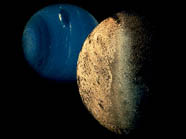





Triton is a moon of Neptune. It is one of the coldest places in the Solar System. Conventional wisdom would suggest it would be a frozen world, solid and still, covered in craters much as many of the other icy moons of the outer planets. Triton's orbit is retrograde - "backwards" in other words - and it is the only large moon in the Solar System to do this. This means that Triton did not form where it now exists orbiting Neptune, but it was captured possibly as it wandered on an elongated orbit from the Kuiper belt - a vast field of comets, miniature planets and icy space debris beyond the orbit of Neptune.
This unusual orbital behavior, particularly when the interaction of this with other moons of Neptune is taken into account, will almost certainly cause tidal heating inside Triton. This would account for what was discovered by the Voyager 2 spacecraft as it zoomed past Triton in 1989. Triton was found to be volcanic, and actively so. However, this was not hot volcanism of the type we associate with Earth and Io, but cold volcanism where melting ices - water, nitrogen, and possibly methane and ammonia - play the part of lava flows and ejecta.
Possibly as a result of this geothermal activity Triton as a thin atmosphere of nitrogen and methane, perhaps up to 10 km (6 miles) deep. The chemicals that have been observed are similar to those known to be associated with Saturn's moon, Titan. They are life precursors, so could there be life on Triton? As with Titan it is almost certainly too cold, with the surface temperature being just 34 K above absolute zero. But deep down, where internal heating occurs, who knows? At the present time we simply do not have enough data to make a reliable assessment, but the temperatures may be high enough for liquid water to exist and if so then simple life could exist on Triton.
© All images NASA
Go
to
Home
| Space Station
| Mars | Rainforest
© 1999 Satellite Events Enterprises Inc.